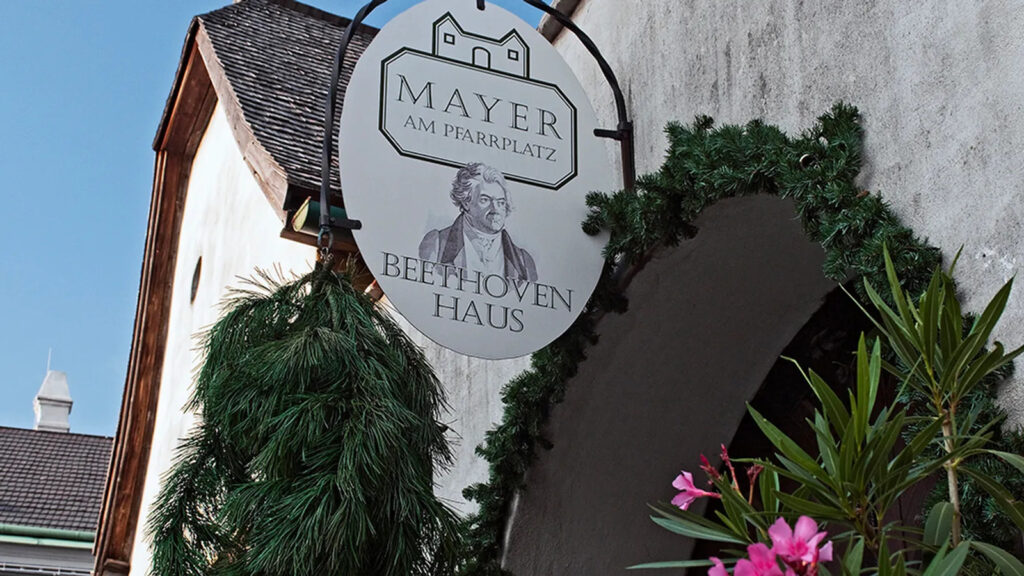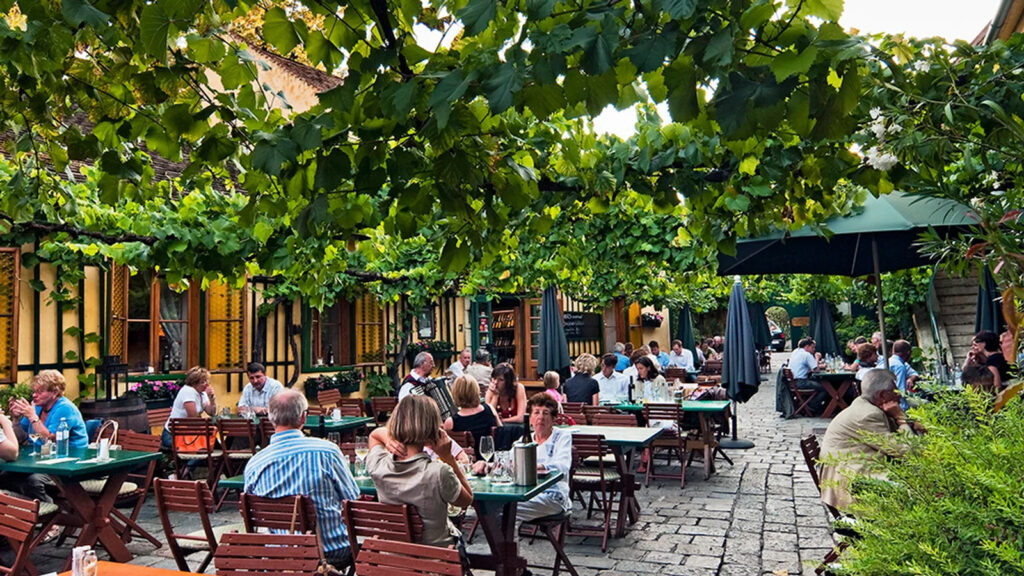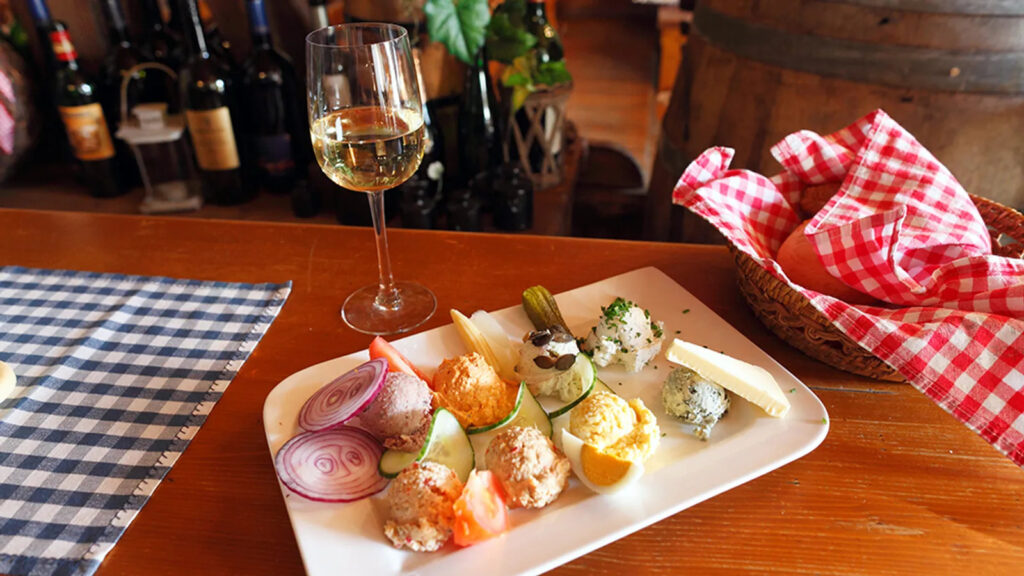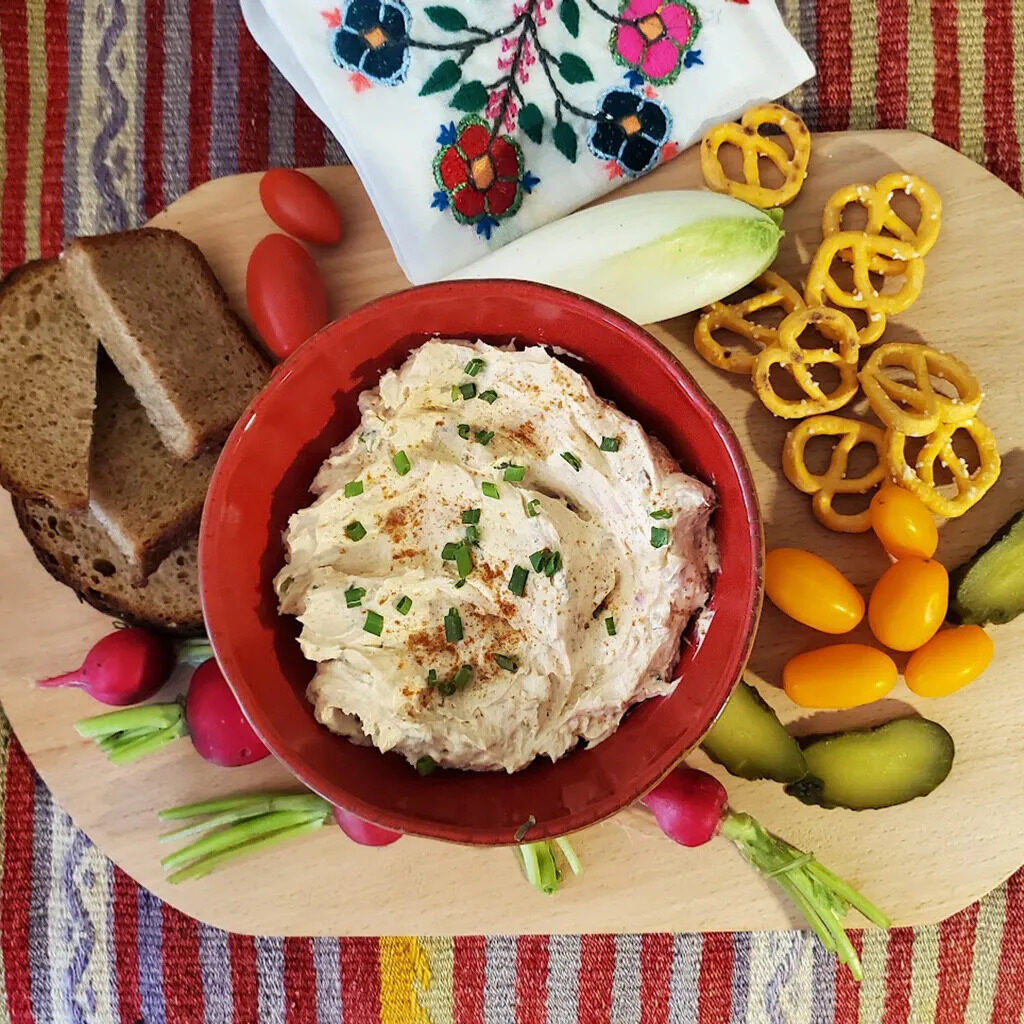Anya von Bremzen, author of the new book, National Dish, explains the origins of liptauer cheese and its presence at Vienna’s rustic, centuries-old winery taverns.
Come warm weather, Vienna’s residents flock to the city’s bucolic outskirts with the determination of migrating birds. Their destinations? Heurigen, the rustic winery-run taverns showing off their aromatic white wines around wooden tables set under grape arbors and laden with traditional Austrian fare that might include schnitzel and blood sausage, always potato salad and ham and a variety of savory cheesy spreads to go with dark sourdough bread.
Paris might have its bars du vin, Rome its enotecas. But Vienna’s relationship to wine (and wine-friendly food) is unique. The Austrian capital is the only major European metropolis with a designated wine-growing area within its city limits, counting more than 600 producers on some 1,700 acres of vineyards.
“Our city’s long viticultural history goes back to the time of the Celts and the Romans,” explained Ilse Heigerth, my guide in Vienna and a city historian.
However, Heurigen (the plural form of Heuriger) as we know them today began to proliferate after 1784. That’s when Hapsburg Emperor Josef IIissued an ordinance allowing farmers to sell their own wine and produce, tax free, directly to customers. Ever since, Heurigen have been hanging their folksy signature buschen (a bunch of evergreen boughs) above their entrances, a sign that the tavern is licensed and open.

“Currently around 70% of Vienna’s annual wine yield is drunk at the capital’s Heurigen,” explained Helena Hartlauer of the Vienna Tourist Board. In 2019, this tavern custom was inscribed in Unesco’s Intangible Heritage List as an example of a time-honoured yet still-vital tradition that helps sustain community culture.
Heurigen have also helped keep Vienna green. “One idea behind Josef II’s decree was to encourage urban agriculture in Vienna,” said Rainer Christ, a pioneering local winemaker currently behind Weinegut Christ, his family’s 400-year old winery, which operates a popular tavern in the city’s Jedlersdorf district.
Another boon is a 1905 law banning real estate development in the city’s green outskirts. “We protected our green suburbs at a time when it wasn’t trendy or popular” said Hartlauer. “So, imagine how proud we are now to’ve been ranked as one of the world’s greenest cities.”
“Talk about ultra-sustainable!” agreed Paul Kiefer, commercial director of Mayer am Pfarrplatz Winery, which operates a tavern in a historic building where Ludwig van Beethoven stayed in 1817 and worked on his iconic 9th Symphony. “From our vineyards to our tables is less than one mile!” Kiefer said. “And by law, all the grapes that we vinify and most of the ingredients for our kitchen, except things like salt, must be from this region.”

The word Heurigen stems from Heurige, meaning “this year’s” wine, as in fresh. “Traditionally, the Viennese were always thirsty for wines that were young and uncomplicated,” said Christ, “nothing you’d ever find on a serious big city list next to bottles from famous Austrian regions like Wachau.”
But that started to change in 2006 when a group of high-minded producers – including Christ, Fritz Wieninger and Mayer am Pfarrplatz – banded together to form WienWein Group. Their aim? To elevate the quality and prestige of Viennese wine, particularly the signature Wiener Gemischter Satz – meaning “mixed set” – a field blend of different grapes all grown, crushed and fermented together.
Their efforts were a resounding success. In the past decade, Vienna’s Gemischter Satz has been elevated from loveable folkloric plonk to the cult cool kid of the Austrian wine scene. “There isn’t a fancy wine list in Vienna and the rest of the country that doesn’t feature it these days,” said Wieninger.
As the quality of local wines has shot up, drawing younger urban sophisticates to rustic Heurigen tables, many taverns have started paying serious attention to food. Besides the classic Austrian canon of schnitzels, backhendl (fried chicken), blood pudding and savory dumplings called Grammelknödel, many Heurigen offer special seasonal menus starring, say, chanterelles or asparagus.
That said, a cold buffet remains the heart of a Heuriger repast. “That’s because the original taverns, while allowed to sell local farm products, didn’t have cooking licenses,” explained Christ. “Many didn’t even have kitchens, and just a few decades ago, locals often brought their own baskets loaded with cold roast pork, cheese and charcuterie, jars of dips, radishes and schmalzbrot [brown bread slathered with pork drippings],” Heigerth added.
“That kind of picnic fare has became the basis for contemporary Heurigen buffets,” said Kiefer. At Mayer am Pfarrplatz, the cold buffet boasts a dizzying array of locavore hams and sausages, potato and cucumber salads as well as crocks holding a dozen different savory spreads.

Among the latter, the sine qua non of a Heuriger meal is a tangy paprika-stained cheese spread known as Liptauer. Served at all taverns, often prepared at homes and featured in Viennese cookbooks, Liptauer is such a local classic, one can forget that it originates in other parts of the former Austro-Hungarian empire. Known as Liptovský Sýr in Slovak and Liptói Túró (or Lörözött) in Hungarian, the spread reflects Vienna’s imperial melting pot food culture.
The dish takes its name from the Liptov region (Liptó in Hungarian) which passed from Hungary to Czechoslovakia in 1918, and is now in Slovakia. Home to the High Tatras mountains, the area was once famous for its fresh tangy cheese called Bryndza (or Brimsen in German) made by shepherds from sheep’s milk coagulated with rennet, then hung in linen cloth to drain for a day.
When the region was still part of the Hapsburg empire, Liptov Brimsen was a prized export to Vienna, according to Austrian journalist Tobias Müller. It was sold there in small wooden barrels, to be eaten on its own or mixed with butter. Two World Wars and 40 years of communism ended this trade relationship, noted Müller. Slovakia’s cheese production became nationalised under communist rule. Meanwhile in Vienna, people started making Liptauer with topfen (soft curd cheese), mixing in piquant flavorings to approximate the briny tang of the original Brimsen.
“These days, every cook makes Liptauer differently,” said Wieninger. “And many customers judge a tavern by the quality of its Liptauer as well as its wine,” added his business partner and wife, Lissi Wieninger. “And ours is famous!”
Depending on the cook, the cheese base can be curd cheese alone or mixed with some butter and/or sour cream. Quark, a product similar to cream cheese in the US also works well. The zesty add-ons, meanwhile, can run the gamut from anchovies to mustard, onions, capers, diced cornichons or caraway seeds – and always paprika for colour. And while rustic rye bread and crunchy veggies like radishes are classic accompaniments, many Austrian Heurigen regulars swear by pretzel sticks. And, of course, Wiener Gemischter Satz, too.

Liptauer cheese spread recipe
By Siegmund Machatschek
Serves 4 to 6
This recipe is from Siegmund Machatschek, the beloved chef at Heuriger Wieninger, which is known for its Liptauer. He uses a base of butter and a creamy Austrian cheese called Speisetopfe, similar to quark, for which cream cheese makes a fine substitute. If you can find it, feel free to use quark instead, or in combination with cream cheese. Whipped cottage cheese or farmer cheese also works well, and to approximate the briny taste of the original Slovakian Brimsen, you can also add some mashed feta. Good-quality Hungarian paprika is a must.
Method
In a mixing bowl, using an electric mixer, cream the butter with all the ingredients except the quark (cream cheese). Add the quark (cream cheese) and beat at low speed until everything is thoroughly combined. Season to taste with salt. Cover and chill for at least 2 hours for the flavors to ripen (or make a day ahead). Bring to room temperature before serving. Garnish with sweet paprika and chives and serve with the suggested accompaniments.
Source : BBC









